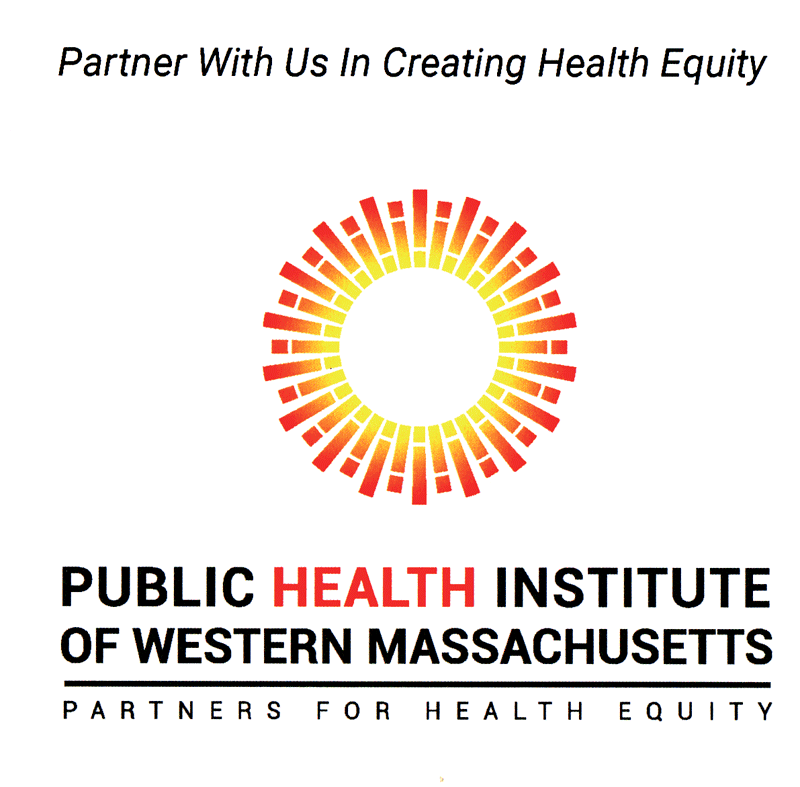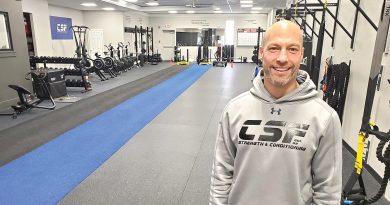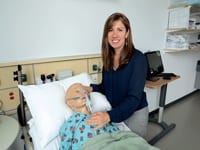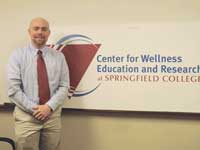New Name, Evolving Mission – ‘Partners’ Becomes Public Health Institute of Western Mass.
As she talked about a rebranding effort involving the agency now formerly known as Partners for a Healthier Community Inc. (PFHC), Jessica Collins said the project wasn’t initiated because the name chosen in 1996 didn’t convey what the nonprofit is or does.
Rather, it’s because the new name eventually chosen — Public Health Institute of Western Massachusetts — and its accompanying logo do the job much better.
Indeed, while the agency is a partner in a number of initiatives to improve overall population health in the region, the original name didn’t convey the full breadth of its portfolio of services, said Collins, its executive director. Nor did it really define just what the ‘community’ in question happens to be.
Most importantly, though, it didn’t fully communicate the agency’s role as a change agent when it comes to the overall health and well-being of the communities it serves and especially those populations that are underserved.
So last fall, PFHC, working in cooperation with the marketing and advertising agency Paul Robbins & Associates, went about coming up something more accurate and specific.
The new name, which was unveiled at an elaborate ceremony at the agency’s offices within the Community Music School building in downtown Springfield, was chosen for several reasons that we’ll get into shortly.
First, though, we need to elaborate on why a rebranding was necessary at this time. Indeed, such initiatives are time-consuming, expensive, and bring change, an always tricky proposition, into the equation.
For starters, PFHC joined the National Network of Public Health Institutes in 2014, Collins said, adding that, as part of the process of joining that organization, the agency needed to identify its core competencies.
And for PFHC, those are research and evaluation, convening and coalition building, and policy and advocacy.
“Given those three core competencies, it felt natural to go with the Public Health Institute of Western Mass., coming from that national perspective,” Collins explained. “Also, there was some confusion about our organization because there are several agencies in the Greater Springfield area that have the word ‘Partners’ already in their title.”
What’s more, a rebrand provides an opportunity for an agency or business re-emphasize its mission, how it is carried out, its history, and its plans for the future. Or “reintroduce itself,” as Collins put it, adding that, for many, the institute needs no introduction, while for many others, it does.
The unveiling of the new name was part of that effort, she said, but there will be other initiatives to build awareness of the overall mission as well as specific projects, such as:
• The Springfield Youth Health Data Project, a health survey among Springfield public-school eighth-graders in 2015 and 2017. The project is part of a larger initiative that includes the Youth Risk Behavior Survey, a tool developed by the Centers for Disease Control and administered to 10th- and 12th-graders in Springfield;
• Springfield Complete Streets, funded by a Robert Wood Johnson Foundation Policies for Action Grant. The initiative involves a study of Springfield’s Complete Streets policy and, specifically, policies that support roadways designed and operated for the safety of everyone using them — whether by car, bike, foot, or bus;
• The Healthy Homes Initiative, which brings together housing and healthcare providers to pay for home improvements in Springfield specifically related to asthma control — mold and moisture remediation, pest control, ventilation and air quality, and removal of carpeting that harbors dust and other allergens — with the goal of keeping asthma sufferers out of the hospital;
• Springfield’s Climate Action & Resilience Plan. The institute is leading the outreach and engagement of residents and key stakeholders around implementation of a plan to make Springfield a resilient, healthy city; and
• Age-friendly City, an initiative that will create a senior leadership program to train older adults to be effective age-friendly community advocates, conduct an environmental scan on housing and transportation, and work toward achieving an age-friendly status for Springfield.
As those projects indicate, the agency has taken even more of that change-agent role, while also becoming more focused on the collection and implementation of the data that is critical when it comes to everything from enacting health-policy changes to winning critical funding for initiatives to improve the health and well-being of neighborhoods, a city, or an entire region.
PFHC needed a new name and logo that brought that message home, and Public Health Institute of Western Mass. does just that.
For this issue, we’ll talk a little about this rebranding effort, and a lot about the institute and the critical work it is undertaking across the region.
Bright Ideas
As mentioned, the new name comes complete with a new logo.
Actually, it’s a remake of the old logo, imagery of a sun. The new look is larger, brighter, and the sun rays, if you will, are aligned to replicate the lines on a bar graph — a nod to the agency’s dual missions to collect data and put that data to use to improve quality of life in the region.
“We had always done the coalition and advocacy building, but over the past few years we’ve really dug deeper into bringing expertise around research and evaluation,” Collins explained. “The new name and logo bring a more academic framing to the work that we’re doing.
“We want people to understand that we’re the place to come to if they want health data — if they want data that is highlighting inequities and, therefore, identifies populations that are in need of more attention and resources and investment,” she went on. “We want people to come to us if they have policy issues and need us to organize and create advocacy strategies, and we want people to come to us, as they always have, if they have new and innovative ideas or if there are gaps and issues that need to be convened around.”
All of this comes across in the new name, where each word or phrase carries some significance: ‘public’ for obvious reasons; ‘health’ (it’s in red while the rest of the words are in black on the letterhead); ‘institute,’ which conveys research and data; and ‘Western Massachusetts,’ because the agency needs to make clear that its work extends well beyond Springfield.
Also, there is a subtitle, ‘Partners for Health Equity,’ which brings home the point that the institute partners with other entities on all of its initiatives, and that its work is focused on making sure that all those in the region have an equal opportunity for a healthy life, regardless of where they live.
While the words and the logo are certainly significant, what’s behind them is what the agency is working to emphasize with this rebranding.
And as we commence that discussion, it’s probably best to go back to the beginning. That was in 1996, when a group of area healthcare leaders, led by Sr. Mary Caritas, then retired from her role as president of Mercy Hospital (now Mercy Medical Center), sought creation of a new public entity focused on improving health and well-being in Greater Springfield.
The goal back then was to create a space where competing health organizations and other entities, including the city of Springfield, could sit at the same table and work together to make the community a healthier place, said Frank Robinson, vice president of Public Health and Community Relations at Baystate Health, who was one of those on the ground floor, if you will.
“With that ambitious agenda, the notion was, ‘what are the things that need to be changed? What’s interfering with a good portion of the Springfield population living healthy lives?’” Robinson explained. “That social-justice framework was at the root of the organization’s inception, and it has maintained that viewpoint.”
The mission has always been to create a measurably healthier community, he continued, putting heavy emphasis on that word. And while the mission hasn’t really shifted, what has happened over the past 21 years is that the focus and the interventions have become more precise, more targeted.
“And with that additional precision and targeting, we’ve become more of a specialist than a generalist,” Robinson explained. “The general work is still occurring, but the specialty work is really taking center stage.”
The agency’s broad role has shifted somewhat as well, he went on, from being merely a supporter of various coalitions to a being a change agent in its own right.
This is reflected in some of the success stories the agency has helped write over the years, including:
• The BEST Oral Health Program, which created a local system of education, screening, and treatment for preschools to decrease instances of oral diseases;
• The Pioneer Valley Asthma Coalition, created to improve asthma management and indoor air quality (two Springfield schools received national recognition for the program, and Holyoke Public Schools adopted similar policies in 2017);
• A “Health Impact Assessment on the Western Massachusetts Casino,” a 2013 study that highlighted the health impact of vulnerable populations and increased community understanding of these potential impacts;
• Live Well Springfield. Undertaken in partnership with the Pioneer Valley Planning Commission, the project is designed to improve access to health eating and active living opportunities. Signature projects undertaken as part of the initiative include the formation of the Springfield Food Policy Council, the sucessful, seven-year Go Fresh Mobile Farmer’s Market, and policies such as zoning, community gardens, and Complete Streets ordinances; and
•The YEAH! (Youth Empowerment Adolescent Health) Network, which engages diverse community stakeholders who work together to create a proactive, comprehensive response to adverse adolescent sexual health and adolescent sexuality. Between 2004 and 2015, there were significant reductions in teen birth rates in Springfield and Holyoke, and work continues to address inequities.
Data Driven
But it is in the collection and use of data that the agency has seen the greatest movement when it comes to its mission and how it has evolved over the past decades.
Indeed, as the nation, the region, and area healthcare providers continue a shift toward population health — keeping residents healthy as opposed to simply treating them when they are sick — data becomes critical, said Robinson.
Elaborating, he said providers, advocates, legislators, and, yes, foundations administering grant money use data to identify problems and where, specifically, they are occurring. But they also use it to create responses to the issues identified by this data.
The agency focuses on population data, which often comes from the state Department of Public Health, Collins explained, adding that it also works with the Springfield public schools to generate data on a large, diverse population.
“And we are able to tease out whether issues are at a block level, a neighborhood, a census track, a city, or county,” Collins explained. “We’re able to analyze data and create the story of what is going on in our region; we’re able to localize the data so people here can understand it and take action.”
Perhaps the best recent example of this is the so-called Healthy Hill Initiative, a broad-ranging effort to improve the health and well-being of those in Springfield’s Old Hill neighborhood, a program that earned the participating partners (and there were many of them) a Healthcare Heroes award (the new recognition program launched by HCN and BusinessWest) in the category of ‘Collaboration in Healthcare.’
“Their plan of action was driven by data provided to them around block groups within that neighborhood concerning health-status indicators such as asthma, obesity, public safety, and more,” Robinson explained. “Mapping that information helped to target the interventions and support the plan; the community organizing is data-driven in the sense that they’re using the data to inform both the intervention and whether they made a difference.”
Another example would the Springfield Health Equity Report, issued in 2014, said Collins, adding that the agency stratified data by race and ethnicity.
“So when you look at an issue like cardiovascular disease, or obesity, or teen-pregnancy rates, having this stratified data is critical,” she explained. “When you look at state-wide rates for teen pregnancy, for example, everyone’s thrilled because the state rate has come down considerably.
“But if you really look at the data and stratify it by race and ethnicity, you’ll see that the white-girl teen-pregnancy rates have gone down significantly, and so have teens of color,” she went on. “But you still see an incredible inequity and disparity between the two populations, and that’s what we try to lift up and shine a light on, so we’re not all clapping and saying ‘our job is done’ — there are still specific populations that need more resources and investment.”
The only way specific coalitions battling health issues ranging from asthma to obesity to teen pregnancy can determine if they are making an impact — and the desired impact — is through this data, Collins went on, adding that this reality not only explains the new name and logo, but, more importantly, where her agency’s emphasis will be moving forward.
Name of the Game
As Collins noted, there were several motivating forces behind this rebrand.
There was an effort to stem confusion given all the agencies with ‘Partners’ in their name, but also the need to better communicate just how much the agency had evolved into a true change agent since it was created in 1996.
But there was also that desire to reintroduce area residents, officials, and other constituencies to the important work it carries out, and to remind all of them that there is considerable work still to do.
So, to that rhetorical question, ‘what’s in a name?’ or, in this case, a new name? Plenty — and it is, for lack of a better term, a healthy exercise.





Comments are closed.